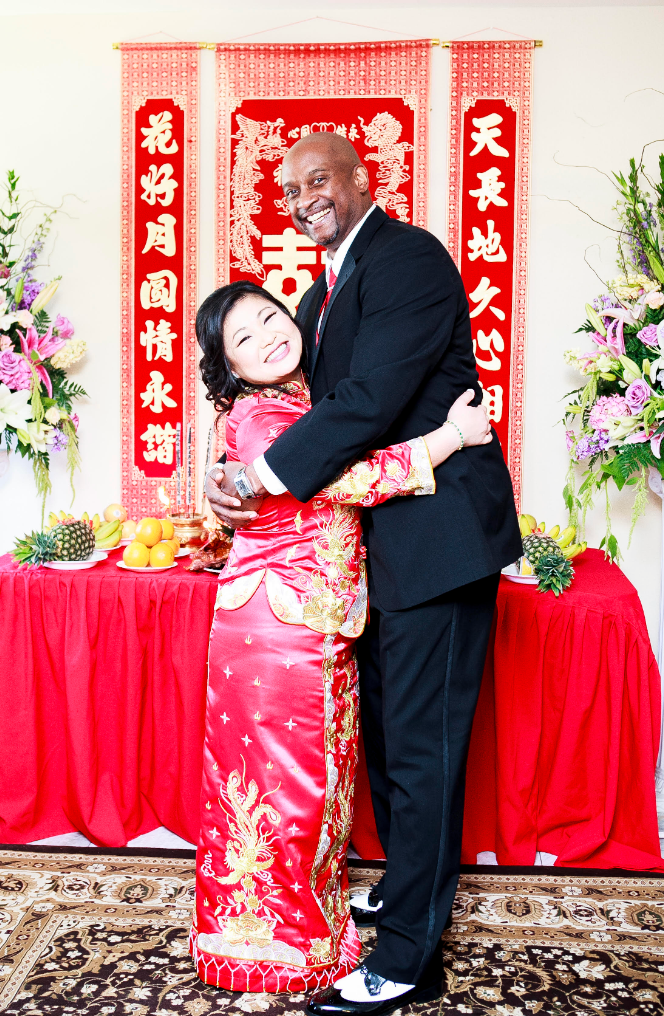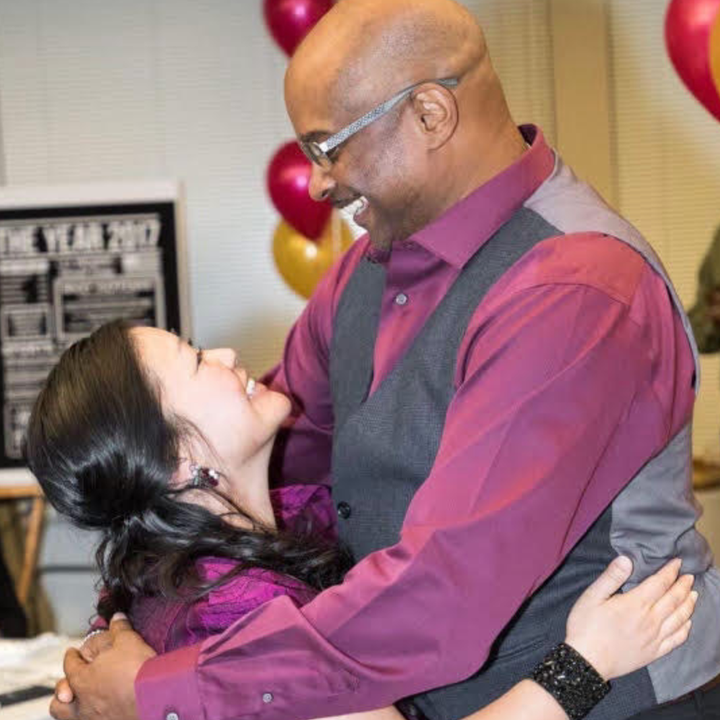
“Are you happy?” a friend asked while we were having dinner one evening. I didn’t even know how to respond to that question. All I could say was, “It’s different,” and without warning, I started crying.
These were tears being shed for all the pain and emotional strife I’d endured, and all the things I’d had to let go of and give up to be standing where I was at that moment after my husband Sean died four years earlier.
At 39 years old, I unexpectedly became a young widow, alone for the first time in over 14 years. I’ve always prided myself on being a very independent and self-sufficient woman who had a career, identity and life outside of the one she had with her husband. However, after Sean’s passing, I realized that I had never “adulted” without him and that we were more co-dependent than I had thought.
Even simple decisions like “What’s for dinner?” had been made jointly, and now I had to go through the hardest, most painful and traumatic experience of my life alone. The confident, independent and self-sufficient woman I had been was nowhere to be found. Instead, there was a terrified woman who couldn’t leave her house without suffering a panic attack.
Most people think the hardest part of widowhood is the pain and grief of losing your life partner. Indeed, the depth and rawness of that pain and those emotions were nothing I’d ever experienced before. Grief is a great equalizer ― it can feel unrelenting and never-ending, and it doesn’t seem to get profoundly better or easier with time. It only becomes more manageable as you learn to live, move and evolve with it.
Grief becomes a part of who you are, but it’s still not the hardest part of widowhood. For me, the hardest part was when I was faced with big questions like, “What’s next? How do I move forward alone? How do I even begin to pick up the shattered pieces of my life?”
I spent the first nine months of widowhood drowning in grief, suffering from PTSD, feeling like all eyes were always on me. I could barely breathe, and normal, everyday routines were challenging. I was uncomfortable in my own skin, and most days, I was just standing still ― scared to make a move while the rest of the world sped past me. I’d spend each evening staring at the front door, willing my husband to come home, but he never did. The only way I was able to cope and get out of bed every morning was to tell myself he was on a very extended business trip.
During that first year after Sean’s death, I was essentially living the same life I had before, except without a husband. I started doing all his chores and picking up his slack. Nobody probably would have even noticed he had died if it weren’t for my newly formed social ineptitude.
In public, I felt awkward, and even people I had known for decades felt like strangers to me. In private, I felt like a caged bird constantly struggling to escape my pain by continually crashing against a closed window. There seemed to be no cure for the sadness, longing and loneliness I constantly felt.

I needed to find a way to accept that I wasn’t a wife anymore ― even if I was still wearing my wedding ring and talking about my husband in the present tense. It was almost impossible at first. Sean’s presence was very much alive in the house, but I was living alone. Our five pets and I even continued to sleep in our normal position as if he was still in bed with us.
I lived like this for almost three years after he passed, straddling the gray area between being married and single. Whether I wanted to or not, I had to make some serious mental, physical and emotional shifts if I wanted to survive.
Eventually, I discovered that reading memoirs, stories and quotes on grief and other widows’ experiences helped. I found solace in artist and author Vivian Greene’s declaration that “Life isn’t about waiting for the storm to pass. It’s about learning how to dance in the rain.” So, that’s what I finally did: I danced in the rain and mustered the courage and strength to push beyond the boundaries of my fear.
Some days, I was successful, but most days, I usually ended up in tears at some point. Still, I refused to give up. I learned to get very comfortable with always being uncomfortable.
“For me, the hardest part was when I was faced with big questions like, 'What’s next? How do I move forward alone?'”
Then, a couple months into my second year of widowhood, everything suddenly turned upside-down with the arrival of COVID-19. With the world preoccupied and distracted by the pandemic, the relentlessly watchful eyes that normally kept tabs on me were turned elsewhere. I finally had the time, space and privacy to process and reflect on my grief in a deeper and more meaningful way without feeling judged or scrutinized by those around me.
What I learned during those first few months of isolation was that I had barely scratched the surface of my grief. I was too afraid to look at my trauma head-on, and for the first time in over two years, being a widow took a backseat to other parts of my life. I realized I was living in a house that was too big for me and working in a role I was ready to leave. By June 2020, I had listed my house for sale, moved into a rental unit, and started a new job.
By October of that year, I had grown increasingly lonely and still felt frustrated, stuck and empty. Although I had made some significant mental and physical shifts in my grief process, I still wasn’t able ― or maybe was unwilling ― to make the emotional shift toward rebuilding a new life without Sean.
The social isolation I was experiencing coupled with having few physical attachments to my old life led me to make an impulsive decision to put my things in storage and move 400 miles to temporarily shelter in place with my parents. At 42, I was a boomerang child, living at home again.
After a few months, I realized the only reason I was in this situation was due to my husband’s death. It made my life seem even more tragic. Although I relished in the newfound joy of living closer to family, I couldn’t help but look at my life through the rearview mirror and fixate on all the things I had lost. I spent the following year sitting squarely in the middle of my pain ― I was disillusioned, hopeless and resigned to believing there was no light at the end of my tunnel.

After crossing the threshold into my fourth year of widowhood, I realized I was wrong about there being no way forward. I now see my third year as a valuable recovery period when I caught my breath, recalibrated and truly started the rebuilding process. Although I had found the courage to approach my grief head-on, too often, I had only focused on the path ahead of me along the seemingly insurmountable mountain I still had to ascend, or the path behind me, which was littered with my suffering and all the things I had to give up. I never took the time to appreciate all the things I had accomplished.
When I finally stopped, stepped back and looked around, I was taken aback by the beautiful and lush terrain that surrounded me. I couldn’t believe I had traversed through all those peaks and valleys for the last four years. By expanding my vantage point, I was able to find gratitude, appreciation and beauty not only in my achievements ― no matter how big or small ― but also in the loss, pain and struggle, which in turn allowed me to find and have patience, compassion and empathy for myself.
Now, I can see I have gained as much as I have lost. I experienced a love so strong and powerful that even in death, it continues to grow, deepen and transcend. I possess a strength, courage and resilience that I didn’t know was possible. I have a support system that came to my aid when I couldn’t take care of myself. I have a group of family and friends who were present to witness my grief by laughing and crying with me without judgment or trying to make me feel better.
And, most importantly, I realized I was never walking alone. Sean’s presence was always beside me, holding my hand, carrying me when I couldn’t walk on my own and guiding me through the pain and darkness. This newly found sense of appreciation and gratitude has made me realize that there are two sides to grief. Yes, there is pain, sadness, loss and fear, but immense love, strength, courage, resilience and healing can also be found.
As I embark on my fourth year of widowhood, I do not know what’s ahead. But I know I will stop fixating solely on my loss, pain and challenges, and focus more on the love, strength and memories Sean and I shared. I will tell my story whenever possible in hopes it may help someone else who is grieving to find hope, strength and the courage to keep moving forward. And I will keep exploring my own grief to learn new lessons and gain more understanding as I patiently welcome the healing I know will continue to come my way.
Sun Yen Cumby is a numbers girl by profession and geeks out on converting data into intelligent decision-making tools. After her husband’s sudden and untimely death, she started to journal and write as a way to process her grief and has come to learn how empowering and cathartic written words can be. She currently resides in Southern California with her two dogs (Bam Bam and Pebbles) and two cats (Sasha and Biscuit).
Do you have a compelling personal story you’d like to see published on HuffPost? Find out what we’re looking for here and send us a pitch.
